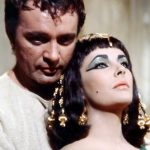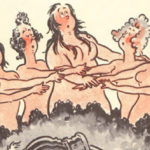 Mysteries
Mysteries  Mysteries
Mysteries  History
History 10 Surprising Stories About the Texas Rangers
 Humans
Humans 10 Philosophers Who Were Driven Mad by Their Own Theories
 Miscellaneous
Miscellaneous 10 Video-Game-Worthy Weapons and Armors from History
 Weird Stuff
Weird Stuff 10 Psychics Who Accurately Predicted Wartime Events
 The Arts
The Arts 10 Pieces of Art Inspired by a Broken Heart
 Health
Health 10 Science Fiction-Sounding New Medical Treatments
 History
History 10 Surprising Facts About the Father of Submarine Warfare
 Space
Space Ten Astonishing New Insights into Alien Worlds
 Weird Stuff
Weird Stuff 10 Bizarre Summer Solstice Rituals Still Practiced Today
 Mysteries
Mysteries Top 10 Haunting Facts About the Ghost Ship MV Alta
 History
History 10 Surprising Stories About the Texas Rangers
 Humans
Humans 10 Philosophers Who Were Driven Mad by Their Own Theories
Who's Behind Listverse?

Jamie Frater
Head Editor
Jamie founded Listverse due to an insatiable desire to share fascinating, obscure, and bizarre facts. He has been a guest speaker on numerous national radio and television stations and is a five time published author.
More About Us Miscellaneous
Miscellaneous 10 Video-Game-Worthy Weapons and Armors from History
 Weird Stuff
Weird Stuff 10 Psychics Who Accurately Predicted Wartime Events
 The Arts
The Arts 10 Pieces of Art Inspired by a Broken Heart
 Health
Health 10 Science Fiction-Sounding New Medical Treatments
 History
History 10 Surprising Facts About the Father of Submarine Warfare
 Space
Space Ten Astonishing New Insights into Alien Worlds
 Weird Stuff
Weird Stuff 10 Bizarre Summer Solstice Rituals Still Practiced Today
Top 10 Powerful but Demonized Women in Mythology
Throughout mythology, there are hundreds of women, many of whom show immense power. These women are often very quickly demonized in the eyes of both contemporary and modern societies when we, in fact, often celebrate their male counterparts for similar actions. Here is a list of ten women from mythologies around the world who have been demonized for their displays of power.
Related: 10 Common Misconceptions About Ancient Greece And Its Myths
10 Lilith
When discussing the topic of demonization and powerful women as a whole, it feels only fitting to begin with the first woman and the original of Adam in Mesopotamian, Abrahamic, and Judaic mythology and religion. Lilith was said to be created by God from the same dust as her husband, Adam, as his equal. She was gifted the Garden of Eden as her home, where, as God commanded, she acted as a steward to the land and animals. For a short time, Lilith and Adam lived in harmony within Eden until Adam decided he was superior to Lilith and attempted to assert his dominance over her.
Adam commanded that Lilith was to lay beneath him during acts of intimacy, but believing them to be equals, Lilith refused. When the first man tried to push the matter, it is said that either Lilith ran from him and the garden or that she sprouted wings and flew to escape his advances. When told of this, God sent three angels to pursue Lilith and bring her back to the Garden. However, when they discovered her, she had changed.
She was crouched in a cave and was birthing monstrous children—demons. The angels commanded her return, but Lilith refused, so the angels said they would kill 100 of her children each day until she returned. In revenge, the myth states Lilith took to Hell as the mother of demons. It is believed that she is responsible for the death of young children—who she swore not to hurt if they bore an amulet inscribed with the names of the three angels—and the birth of stillborn babies. Although she became a demon, Lilith’s actions were to protect herself. Thus she was removed from future religious texts, but she is still viewed as a feminist icon today.[1]
9 Medea
This sweet but psycho princess story is one of magic, anger, and gore—a tale that, if a man were to have committed her actions, would hardly have been commented on. In Greek mythology, Medea was the granddaughter of Helios, Titan god of the sun. She was raised on the island of Colchis, a land of witches, monsters, and dragons, by the cruel necromancer, Aeetes. So her upbringing was questionable, to say the least.
Her life wasn’t much improved when the hero Jason arrived on her father’s shores demanding his most prized possession, the Golden Fleece. It was at this moment that the goddess of love, Aphrodite, enchanted Medea so that she fell in love with Jason. Medea used her magic to help Jason in his quest, he managed to steal the fleece, and they escaped, but only after Medea had chopped up her brother and thrown his body parts into the ocean to slow down her father’s pursuit.
Later in their tale, to win Jason back his kingdom, Medea tricked three girls into killing their father. And finally, after years and children, Jason announced he was cheating on and leaving Medea even after all she had done for him. Instantly, Aphrodite’s love voodoo spell was shattered, as was Medea’s mind. So in a fit of rage, she slaughtered Jason’s new love and her own children, taking their bodies and flying away in a dragon-flown chariot.[2]
8 Morgan Le Fey
Originally Morgan Le Fey (the Faerie) was a healer to King Arthur in the Arthurian legends. However, as her powers grew throughout the tales, her character was manipulated from a physician dedicated to helping others to one of the most wicked sorceresses of legend. Throughout her tale and as her power grew, Morgan had various affairs and began to use her magic to try and bring about the fall of Camelot and her half-brother Arthur.
She attempted to split up his marriage with Guinevere, trapped him in the Faerie land, and even escaped her comeuppance by transfiguring herself and her companions to stone for years before becoming flesh once again. Her final act of evil was sending a cursed robe to Arthur and Guinevere, but this failed when they requested a serving girl put it. Unfortunately, she immediately went up in flames.[3]
7 Morgause
Perhaps even worse than her sister, Morgan, Morgause also begins her tale as a Faerie healer. However, as her powers grew, her actions grew even more heinous than those of her sister. Morgause married King Lot of Orkney and visited Camelot. Although she knew of her half-brother, King Arthur, he did not know of her. She lured him to her bed, and together they conceived Mordred.
Despite Arthurs’s attempts to later have his son killed, Morgause raised him in secret and taught him that his father was a cruel man who stole her birthright, the throne of Camelot. After many years, the characters of Morgan and Morgause were merged into one being, a Faerie healer whose power scared men. And thus, she became an evil enchantress.[4]
6 Pasiphaë
This queen of Crete was the daughter of Helios and a minor goddess of the sun revered by all. It was only when her power as a witch was discovered that she was demonized. Immediately, she was forced to marry a mortal man and then was cast aside by the gods. Humans also feared her for having a power they could not understand. To make matters worse, her husband then proceeded to offend the gods, resulting in her being cursed to mate with a bull, thus creating the minotaur.
Rather than her husband being blamed—as he rightly should have been—Pasiphae was cast aside by her people and her husband. Her husband, Minos, then took various lovers and did not hide it, humiliating her further. And so, as a woman who knew her worth, Pasiphae enchanted Minos so that when he reached a moment of climax with these girls, he would ejaculate scorpions into them, and they would die. These later actions are why people have deemed her evil when it was her husband and his actions that drove her to such extremes.[5]
5 The Morrigan
Within Celtic myths and legends, no deity is feared more than the Morrigan (Phantom Queen). She is a goddess of three parts: Nemain (havoc), Macha (war), and her crow form, Badb (death). It was said that the Morrigan would stalk battlefields as a goddess of fate, war, and death and pick the warriors who would live or die in a battle. She would appear before soldiers washing blood-stained armor if they were destined to die. So she was seen as an evil omen and was feared greatly.
She was a gifted shapeshifter and was known to favor changing into the crow. The Morrigan was one of the Tuatha De Danann, the folk of the Goddess Danu. The warrior race of gods and ferocious warriors were one of the six groups of people that, over the course of history, are said to have settled in Ireland according to the Lebor gabála Érenn (or Book of Invasions) dated to about the 11th century. [6]
4 Ereshkigal
Known by other names, including Allatu and Irkalla, Ereshkigal was a goddess in Mesopotamian mythology who was captured by the demon dragon of the Underworld Kur—a name synonymous with the Underworld. Many gods traveled to rescue the goddess, but by the time they had slain Kur, Ereshkigal had settled into her role as the goddess and new queen of the Underworld.
As she gained power from this title, people instantly began to demonize Ereshkigal. Her name and the name of the Underworld changed to Irkalla, and her actions became questionable. She even goes as far as to kidnap the war god, Nergal, and force him into marriage—much like Hades did in the Greek myths. It is even said that Ereshkigal was the basis for Kore, who later became Persephone.[7]
3 Nyx
There is no deity in Greek mythology more feared than Nyx, the goddess of Night. Born from Chaos—or Phanes and Ananke, depending on the source—alongside Erebus (Darkness) and Gaia (Earth,) Nyx resided deep in the Underworld. As the sun set each day, Nyx would leave her palace in a chariot pulled by black horses and throw a veil across the world, shrouding it in the darkness of night. Although Nyx does nothing inherently evil, she was feared by all, even Zeus. He dared not chase after Hypnos when he ran to Nyx, his mother, for protection.[8]
2 Loviatar
Like most deities of death, disease, and the Underworld, Loviatar was greatly feared within Finnish mythology. She had great power and is described as a blind, wretched daughter with a black heart intent on releasing wicked spirits upon the Earth. Despite being a virgin in all the myths, she is the mother of all diseases and is said to be hideous. When her appearance and intent are compared to her male counterparts in other mythologies, such as Hades, Thanatos, or Osiris, it brings into question why it seems that they are peaceful and, in some cases, attractive. In contrast, as a woman with power, she is described as an evil and ugly hag.[9]
1 Circe
The final woman in this list may be the most well-known witch in western literature, another daughter of Helios treated even more unfairly than her sister Pasiphae. Circe discovered her magic (power outside of her godly abilities) quite early, and she indeed did questionable things with it at the beginning, such as transforming the beautiful Scylla into a monster out of jealousy. When the gods discovered that she held such power, her punishment was far worse than her siblings—the two boys receiving none and Pasiphae being forced to marry a mortal.
Circe was sent to the remote island of Aeaea alone, where she was trapped surrounded by wolves and lions, which she spent time taming. Circe remained content on her island for many years in solitude until Odysseus and his men arrived on her shores. Fearing an attack from the strangers–which “heroes” were well known for–she transfigured Odysseus’s crew into pigs.
For this, she was labeled evil and greatly demonized when she was merely protecting herself and her home from any attack she believed to be coming. The demonization of Circe can be seen in her punishment. She, a powerful woman, was banished to an island to be alone for all time, and her sister was forced to marry below her status and was humiliated. On the other hand, her two brothers were allowed to roam free, Aeetes founding Colchis and Perseis traveling to conquer other lands.[10]








